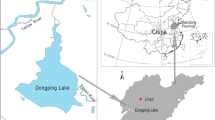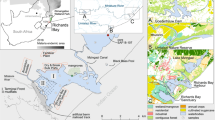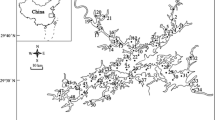Abstract
Burial characteristics and risks associated with 13 organochlorine pesticides (OCPs; α-HCH, β-HCH, γ-HCH, δ-HCH, p,p′-DDE, p,p′-DDD, p,p′-DDT, heptachlor, aldrin, dieldrin, endrin, α-endosulfan and β-endosulfan) in core sediments of Lake Baiyangdian were investigated. The core sediments were taken from areas of different anthropogenic activity along the lake. Concentrations of hexachlorocyclohexane (HCH), dichlorodiphenyltrichloroethane (DDT), heptachlor, aldrin, and endosulfan ranged from 0.64 to 2.72, nd (undetectable levels) to 2.79, 0.29 to 1.37, nd to 2.62, and nd to 1.76 ng g−1, respectively. Concentrations of OCPs in the core sediments exhibited the following spatial trend: Dongtianzhuang > Shaochedian > Zaolinzhuang. Concentrations in the surficial layer were also found to be greater than those in the bottom layer. OCPs were dominated by HCH. β-HCH was found in the greatest concentrations, indicating that the majority of HCH came from older inputs to the area. The ratio of DDT and its metabolites (DDD and DDE) also suggested a lack of recent inputs to the lake environment. The residues of heptachlor, aldrin, and endosulfan in core sediments indicated that cyclodienes were historically applied in the area. The OCP risk assessment, which was based on effect range low and threshold effect level values, suggested that the top layer of sediment in Dongtianzhuang cores had a relatively high toxicity to human health and the environment.




Similar content being viewed by others
References
Aislabie JM, Richards NK, Boul HL (1997) Microbial degradation of DDT and its residues: a review. N Z J Agric Res 40:269–282
Atmakuru R, Ambalatharasu V (2002) Environmental exposure to residues after aerial spraying of endosulfan: residues in cow milk, fish, water, soil and cashew leaf in Kasargode, Kerala, India. Pest Manag Sci 58(10):1048–1054
ATSDR (2002) Toxicological profile for aldrin and dieldrin. US Department of Health and Human Services, Public Health Service, Atlanta
Barakat AO, Mostafa A, Wade TL, Sweet ST, El Sayed NB (2012) Spatial distribution and temporal trends of persistent organochlorine pollutants in sediments from Lake Maryut, Alexandris, Egypt. Mar Pollut Bull 64:395–404
CCME (2002) Canadian environmental quality guidelines. Canadian Council of Ministers of the Environment, Winnipeg
Dai GH, Liu XH, Liang G, Han X, Shi L, Cheng DM, Gong WW (2011) Distribution of organochlorine pesticides (OCPs) and polychlorinated biphenyls (PCBs) in surface water and sediments from Baiyangdian Lake in North China. J Environ Sci 23(10):1640–1649
Doong RA, Sun YC, Liao PL, Peng CK, Wu SC (2002) Distribution and fate of organochlorine pesticide residues in sediments from the selected rivers in Taiwan. Chemosphere 48:237–246
Gao HF, Bai JH, Xiao R, Liu PP, Jiang W, Wang JJ (2013) Levels, sources and risk assessment of trace elements in wetland soils of a typical shallow freshwater lake, China. Stoch Environ Res Risk Assess 27:275–284
Guo W, Pei YS, Yang ZF, Wang CH (2011) Assessment on the distribution and partitioning characteristics of polycyclic aromatic hydrocarbons (PAHs) in Lake Baiyangdian, a shallow freshwater lake in China. J Environ Monit 13:681–688
Hong HS, Chen WQ, Li X (1999) Distribution and fate of organochlorine pollutants in the Pearl River Estuary. Mar Pollut Bull 39:376–382
Hu LM, Zhang G, Zheng BH, Qin YW, Lin T, Guo ZG (2009) Occurrence and distribution of organochlorine pesticides (OCPs) in surface sediments of the Bohai Sea, China. Chemosphere 77:663–672
Hu GC, Luo XJ, Li FC, Dai JY, Guo JY, Chen SJ, Hong C, Mai BX, Xu MQ (2010) Organochlorine compounds and polycyclic aromatic hydrocarbons in surface sediment from Baiyangdian Lake, North China: concentrations, sources profiles and potential risk. J Environ Sci 22:176–183
Jiang YF, Wang XT, Jia Y, Wang F, Wu MH, Sheng GY, Fu JM (2009) Occurrence, distribution and possible sources of organochlorine pesticides in agricultural soils of Shanghai, China. J Hazard Mater 170:989–997
Kalantari MR, Ebadi AG (2006) Study and Measurment of some persisten organochlorine residues in sediments from the two great rivers (Tajan an Neka) of Mazandaran province (Iran). J Appl Sci 6(5):1028–1032
Kalantzi QI, Alcock RE, Joneston PA, Santillo D, Stringer RL, Thomas GO, Jones KC (2001) The global distribution of PCBs and organochlorine pesticides in butter. Environ Sci Technol 35:1013–1018
Kim JH, Smith A (2001) Distribution of organochlorine pesticides in soils from South Korea. Chemosphere 43:137–140
Kuranchie-Mensah H, Atiemo SM, Palm LMN, Blankson-Arthur S, Tutu AO, Fosu P (2012) Determination of organochlorine pesticide residue in sediment and water from the Densu river basin, Ghana. Chemosphere 86:286–292
Lahr J, Maas-Diepeveen JL, Stuijfzand SC, Leonards PEG, Drüke JM, Lücker S, Espeldoorn A, Kerkum LCM, van Stee LLP, Hendriks AJ (2003) Responses in sediment bioassays used in the Netherlands: can observed toxicity be explained by routinely monitored priority pollutants? Water Res 37:1691–1710
Laws EA (2000) Aquatic pollution, 3rd edn. Wiley, New York
Lee KT, Tanabe S, Koh CH (2001) Distribution of organochlorine pesticides in sediments from Kyeonggi bay and nearby areas, Korea. Environ Pollut 114:207–213
Li YF (1999) Global technical hexachlorocyclohexane usage and its contamination consequences in the environment: from 1948 to 1997. Sci Total Environ 232:121–158
Li YF, Barrie LA, Bidleman TF, McConell LL (1998) Global hexachlorocyclohexane use trends and their impact on the arctic atmospheric environment. Geophys Res Lett 25:39–42
Li HL, Gao H, Zhu C, Li GG, Yang F, Gong ZY, Lian J (2009) Spatial and temporal distribution of polycyclic aromatic hydrocarbons (PAHs) in sediments of the Nansi Lake, China. Environ Monit Assess 154:469–478
Li HS, Ling WF, Lin CX (2011) Fishpond sediment-borne DDTs and HCHs in the Pearl River Delta: characteristics, environmental risk and fate following the use of the sediment as plant growth media. J Hazard Mater 186:1474–1480
Liu M, Cheng S, Ou D, Yang Y, Liu H, Hou L, Gao L, Xu S (2008) Organochlorine pesticides in surface sediments and suspended particulate matter from the Yangtze estuary, China. Environ Pollut 156:168–173
Liu GM, Li JCZ, Yin LL, Liu LY, Qi H, Wu YN (2012) Distribution characteristics of organochlorine pesticides in surface and vertical sediments from the Zha Long Wetland, China. Environ Sci Pollut Res 19:2681–2689
Liu C, Li K, Yu LP, Xu YP, Huang BB, Wu JD, Wang ZJ (2013) POPs and their ecological risk in sewage sludge of waste water treatment plants in Beijing, China. Stoch Environ Res Risk Assess. doi:10.1007/s00477-013-0693-2
Long ER, Macdonald DD, Smith SL, Calder FD (1995) Incidence of adverse biological effects with ranges of chemical concentrations in marine and estuarine sediments. Environ Manag 19(1):81–97
MacDonald DD (1994) Approach to the assessment of sediment quality in Florida coastal water, vol 1. In: Development and evaluation of sediment quality assessment guidelines. MacDonald environmental services (Ladysmith, BC), report prepared for Florida Department of Environmental Protection. Office of Water Policy, Tallahassee, p 123
Mai BX, Li Z, Zhan G, Sheng GY, Kang YH, Peng PA (2001) The pollution situation and risk assessment of toxic organic compounds in sediments from Pearl River Delta. Res Environ Sci 14:19–23 (in Chinese)
Miglioranza KSB, de Moreno JEA, Moreno VJ (2004) Organochlorine pesticides sequestered in the aquatic macrophyte Schoenoplectus californicus (C.A. Meyer) Sojak from a shallow lake in Argentina. Water Res 38:1765–1772
Monirith I, Ueno D, Takahashi S, Nakata H, Sudaryanto A, Subramanian A, Karuppiah S, Ismail A, Muchtar M, Zheng J, Richardson BJ, Prudente M, Hue ND, Tana TS, Tkalin AV, Tanabe S (2003) Asia-Pacific mussel watch: monitoring contamination of persistent organochlorine compounds in coastal waters of Asian countries. Mar Pollut Bull 46:281–300
Poolpak T, Pokethitiyookk P, Kruatrachue M, Arjarasirikoon U, Thanwaniwat N (2008) Residue analysis of organochlorine pesticides in the Mae Klong river of Central Thailand. J Hazard Mater 156:230–239
Shi Z, Tao S, Pan B, Liu WX, Shen WR (2007) Partioning and source diagnostics of polycyclic aromatic hydrocarbons in rivers in Tianjin, China. Environ Pollut 146:492–500
Smith SL, MacDonald DD, Keenleyside KA, Ingersoll CG, Field J (1996) A preliminary evaluation of sediment quality assessment values for freshwater ecosystems. J Great Lakes Res 22:624–638
Strandberg B, Bavel BV, Bergqvist PA, Broman D, Ishaq R, Naf C, Pettersen H, Rappe C (1998) Occurrence, sedimentation and spatial variations of organochlorines contaminants in settling particulate matter and sediments in the northern part of the Baltic Sea. Environ Sci Technol 32:1754–1759
Sudaryanto A, Isobe T, Takahashi S, Tanabe S (2011) Assessment of persistent organic pollutants in sediments from Lower Mekong River Basin. Chemosphere 82:679–686
Sun J, Feng J, Liu Q, Li Q (2010) Distribution and sources of organochlorine pesticides (OCPs) in sediments from upper reach of Huaihe River, East China. J Hazard Mater 184:141–146
Tan L, He MC, Men B, Lin CY (2009) Distribution and sources of organochlorine pesticides in water and sediments from Daliao River estuary of Liaodong Bay, Bohai Sea (China). Estuar Coast Shelf Sci 84:119–127
Tao S, Liu W, Li Y, Yang Y, Zu Q, Li B, Cao J (2008) Organochlorine pesticides contaminated surface soil as reemission source in the Haihe Plain, China. Environ Sci Technol 42:8395–8400
United Nations Environment Programme/United Nations Development Programme (UNEP/UNDP) (2001) World development report 2001: making new technologies work for human development, Geneva. http://www.pops.int
Vagi MC, Petsas AS, Kostopoulou MN, Karamanoli MK, Lekkas TD (2007) Determination of organochlorine pesticides in marine sediments samples using ultrasonic solvent extraction followed by GC/ECD. Desalination 210:146–154
Walker K, Vallero DA, Lewis RG (1999) Factors influencing the distribution of lindane and other hexachlorocyclohexanes in the environment. Environ Sci Technol 33:4373–4378
Willett KL, Ulrich EM, Hites RA (1998) Differential toxicity and environmental fates of hexachlorocyclohexane isomers. Environ Sci Technol 32:2197–2207
Xuan FH, Zang SY (2011) Evaluation of risk associated with organochlorine pesticide contaminated sediment of the Lake Lianhuan watershed. Ecotoxicology 20:1090–1098
Xue N, Zhang D, Xa X (2006) Organochlorine pesticide multiresidues in surface sediments from Beijing Guanting reservoir. Water Res 40:183–194
Yang RQ, Lv AH, Shi JB, Jiang GB (2005) The levels and distribution of organochlorine pesticides (OCPs) in sediments from the Haihe River, China. Chemosphere 61:347–354
Yang W, Yang ZF, Qin Y (2011) An optimization approach for sustainable release of e-flows for lake restoration and preservation: model development and a case study of Baiyangdian Lake, China. Ecol Model 222(14):2448–2455
Zhao ZH, Zhang L, Wu JL, Fan CX (2009) Distribution and bioaccumulation of organochlorine pesticides in surface sediments and benthic organisms from Taihu Lake, China. Chemosphere 77:1191–1198
Acknowledgments
This study was funded by Grants from the National Natural Science Foundation of China (41201509). Additional funding was provided by the Fundamental Research Funds for the Central Universities of China and the Natural Science Foundation of Hebei Province (No. B2011502017).
Author information
Authors and Affiliations
Corresponding author
Rights and permissions
About this article
Cite this article
Guo, W., Zhang, H., Cui, S. et al. Assessment of the distribution and risks of organochlorine pesticides in core sediments from areas of different human activity on Lake Baiyangdian, China. Stoch Environ Res Risk Assess 28, 1035–1044 (2014). https://doi.org/10.1007/s00477-013-0799-6
Published:
Issue Date:
DOI: https://doi.org/10.1007/s00477-013-0799-6




